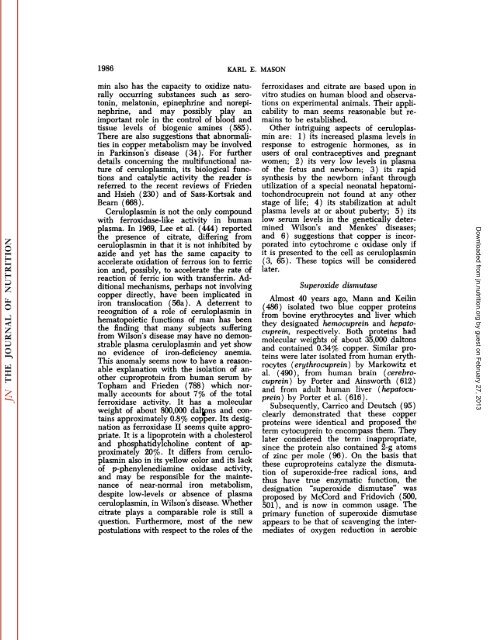conspectus of researchon copper metabolism and requirements
conspectus of researchon copper metabolism and requirements
conspectus of researchon copper metabolism and requirements
You also want an ePaper? Increase the reach of your titles
YUMPU automatically turns print PDFs into web optimized ePapers that Google loves.
1986 KARL E. MASON<br />
min also has the capacity to oxidize natu<br />
rally occurring substances such as sero<br />
tonin, melatonin, epinephrine <strong>and</strong> norepinephrine,<br />
<strong>and</strong> may possibly play an<br />
important role in the control <strong>of</strong> blood <strong>and</strong><br />
tissue levels <strong>of</strong> biogenic amines (585).<br />
There are also suggestions that abnormali<br />
ties in <strong>copper</strong> <strong>metabolism</strong> may be involved<br />
in Parkinson's disease (34). For further<br />
details concerning the multifunctional na<br />
ture <strong>of</strong> ceruloplasmin, its biological func<br />
tions <strong>and</strong> catalytic activity the reader is<br />
referred to the recent reviews <strong>of</strong> Frieden<br />
<strong>and</strong> Hsieh (230) <strong>and</strong> <strong>of</strong> Sass-Kortsak <strong>and</strong><br />
Beam (668).<br />
Ceruloplasmin is not the only compound<br />
with ferroxidase-like activity in human<br />
plasma. In 1969, Lee et al. (444) reported<br />
the presence <strong>of</strong> citrate, differing from<br />
ceruloplasmin in that it is not inhibited by<br />
azide <strong>and</strong> yet has the same capacity to<br />
accelerate oxidation <strong>of</strong> ferrous ion to ferric<br />
ion <strong>and</strong>, possibly, to accelerate the rate <strong>of</strong><br />
reaction <strong>of</strong> ferric ion with transferrin. Ad<br />
ditional mechanisms, perhaps not involving<br />
<strong>copper</strong> directly, have been implicated in<br />
iron translocation (56a). A deterrent to<br />
recognition <strong>of</strong> a role <strong>of</strong> ceruloplasmin in<br />
hematopoietic functions <strong>of</strong> man has been<br />
the finding that many subjects suffering<br />
from Wilson's disease may have no demon<br />
strable plasma ceruloplasmin <strong>and</strong> yet show<br />
no evidence <strong>of</strong> iron-deficiency anemia.<br />
This anomaly seems now to have a reason<br />
able explanation with the isolation <strong>of</strong> an<br />
other cuproprotein from human serum by<br />
Topham <strong>and</strong> Frieden (788) which nor<br />
mally accounts for about 1% <strong>of</strong> the total<br />
ferroxidase activity. It has a molecular<br />
weight <strong>of</strong> about 800,000 daltpns <strong>and</strong> con<br />
tains approximately 0.8% <strong>copper</strong>. Its desig<br />
nation as ferroxidase II seems quite appro<br />
priate. It is a lipoprotein with a cholesterol<br />
<strong>and</strong> phosphatidylcholine content <strong>of</strong> ap<br />
proximately 207o- It differs from cerulo<br />
plasmin also in its yellow color <strong>and</strong> its lack<br />
<strong>of</strong> p-phenylenediamine oxidase activity,<br />
<strong>and</strong> may be responsible for the mainte<br />
nance <strong>of</strong> near-normal iron <strong>metabolism</strong>,<br />
despite low-levels or absence <strong>of</strong> plasma<br />
ceruloplasmin, in Wilson's disease. Whether<br />
citrate plays a comparable role is still a<br />
question. Furthermore, most <strong>of</strong> the new<br />
postulations with respect to the roles <strong>of</strong> the<br />
ferroxidases <strong>and</strong> citrate are based upon in<br />
vitro studies on human blood <strong>and</strong> observa<br />
tions on experimental animals. Their appli<br />
cability to man seems reasonable but re<br />
mains to be established.<br />
Other intriguing aspects <strong>of</strong> ceruloplas<br />
min are: 1) its increased plasma levels in<br />
response to estrogenic hormones, as in<br />
users <strong>of</strong> oral contraceptives <strong>and</strong> pregnant<br />
women; 2) its very low levels in plasma<br />
<strong>of</strong> the fetus <strong>and</strong> newborn; 3) its rapid<br />
synthesis by the newborn infant through<br />
utilization <strong>of</strong> a special neonatal hepatomitochondrocuprein<br />
not found at any other<br />
stage <strong>of</strong> life; 4) its stabilization at adult<br />
plasma levels at or about puberty; 5) its<br />
low serum levels in the genetically deter<br />
mined Wilson's <strong>and</strong> Menkes' diseases;<br />
<strong>and</strong> 6) suggestions that <strong>copper</strong> is incor<br />
porated into cytochrome c oxidase only if<br />
it is presented to the cell as ceruloplasmin<br />
(3, 65). These topics will be considered<br />
later.<br />
Superoxide dismutase<br />
Almost 40 years ago, Mann <strong>and</strong> Keilin<br />
(486) isolated two blue <strong>copper</strong> proteins<br />
from bovine erythrocytes <strong>and</strong> liver which<br />
they designated hemocuprein <strong>and</strong> hepatocuprein,<br />
respectively. Both proteins had<br />
molecular weights <strong>of</strong> about 35,000 daltons<br />
<strong>and</strong> contained 0.34% <strong>copper</strong>. Similar pro<br />
teins were later isolated from human eryth<br />
rocytes (erythrocuprein) by Markowitz et<br />
al. (490), from human brain (cerebrocuprein)<br />
by Porter <strong>and</strong> Ainsworth (612)<br />
<strong>and</strong> from adult human liver (hepatocuprein)<br />
by Porter et al. (616).<br />
Subsequently, Carneo <strong>and</strong> Deutsch (95)<br />
clearly demonstrated that these <strong>copper</strong><br />
proteins were identical <strong>and</strong> proposed the<br />
term cytocuprein to encompass them. They<br />
later considered the term inappropriate,<br />
since the protein also contained 2-g atoms<br />
<strong>of</strong> zinc per mole (96). On the basis that<br />
these cuproproteins catalyze the dismutation<br />
<strong>of</strong> superoxide-free radical ions, <strong>and</strong><br />
thus have true enzymatic function, the<br />
designation "superoxide dismutase" was<br />
proposed by McCord <strong>and</strong> Fridovich (500,<br />
501), <strong>and</strong> is now in common usage. The<br />
primary function <strong>of</strong> superoxide dismutase<br />
appears to be that <strong>of</strong> scavenging the inter<br />
mediates <strong>of</strong> oxygen reduction in aerobic<br />
Downloaded from<br />
jn.nutrition.org<br />
by guest on February 27, 2013
















